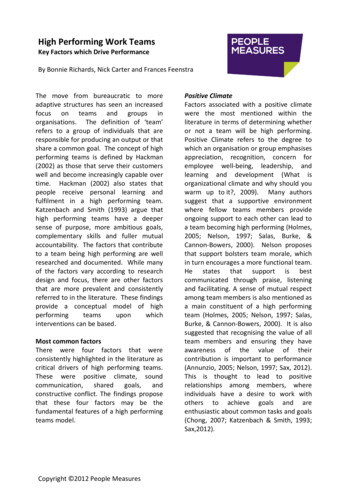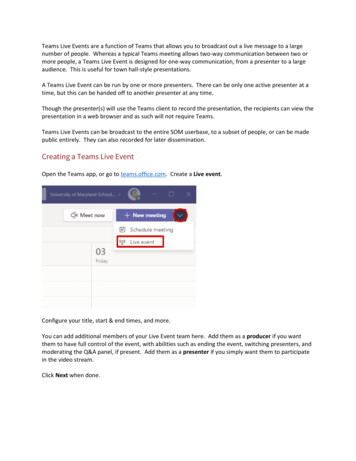
Transcription
High Performing Work TeamsKey Factors which Drive PerformanceBy Bonnie Richards, Nick Carter and Frances FeenstraThe move from bureaucratic to moreadaptive structures has seen an increasedfocus on teams and groups inorganisations. The definition of ‘team’refers to a group of individuals that areresponsible for producing an output or thatshare a common goal. The concept of highperforming teams is defined by Hackman(2002) as those that serve their customerswell and become increasingly capable overtime. Hackman (2002) also states thatpeople receive personal learning andfulfilment in a high performing team.Katzenbach and Smith (1993) argue thathigh performing teams have a deepersense of purpose, more ambitious goals,complementary skills and fuller mutualaccountability. The factors that contributeto a team being high performing are wellresearched and documented. While manyof the factors vary according to researchdesign and focus, there are other factorsthat are more prevalent and consistentlyreferred to in the literature. These findingsprovide a conceptual model of highperformingteamsuponwhichinterventions can be based.Most common factorsThere were four factors that wereconsistently highlighted in the literature ascritical drivers of high performing teams.These were positive climate, soundcommunication, sharedgoals, andconstructive conflict. The findings proposethat these four factors may be thefundamental features of a high performingteams model.Copyright 2012 People MeasuresPositive ClimateFactors associated with a positive climatewere the most mentioned within theliterature in terms of determining whetheror not a team will be high performing.Positive Climate refers to the degree towhich an organisation or group emphasisesappreciation, recognition, concern foremployee well-being, leadership, andlearning and development (What isorganizational climate and why should youwarm up to it?, 2009). Many authorssuggest that a supportive environmentwhere fellow teams members provideongoing support to each other can lead toa team becoming high performing (Holmes,2005; Nelson, 1997; Salas, Burke, &Cannon-Bowers, 2000). Nelson proposesthat support bolsters team morale, whichin turn encourages a more functional team.He states that support is bestcommunicated through praise, listeningand facilitating. A sense of mutual respectamong team members is also mentioned asa main constituent of a high performingteam (Holmes, 2005; Nelson, 1997; Salas,Burke, & Cannon-Bowers, 2000). It is alsosuggested that recognising the value of allteam members and ensuring they haveawareness of the value of theircontribution is important to performance(Annunzio, 2005; Nelson, 1997; Sax, 2012).This is thought to lead to positiverelationships among members, whereindividuals have a desire to work withothers to achieve goals and areenthusiastic about common tasks and goals(Chong, 2007; Katzenbach & Smith, 1993;Sax,2012).
Sound CommunicationAccording to the literature, effective andconsistentcommunicationisofconsiderable importance to highperforming teams. Research has foundthat the effectiveness of team membercommunication has a considerableimpact on group effectiveness (Dina,2010). It has been found that teams aremore effective if they are committed toopen communication (Holmes, 2005;Nelson, 1997). This involves freelysharing information between teammembers, being open and honest,listening to all team members andproviding positive and constructivefeedback (Holmes, 2005).Theseprocesses allow for team learning, theexpression of a range of ideas, a commonunderstanding of purpose and theprovision of feedback (Brueller &Carmeli, 2011; Katzenbach & Smith,1993; Salas, Burke, & Cannon-Bowers,2000). Brueller & Carmeli (2011) statethat team learning processes such asseeking feedback and reflecting onprocesses and performance are essentialto enhancing team performance, as itenables the team to have a betterunderstanding of their situation. A studyby Sampson & Clark (2011) found thatindividuals in a high performing groupwere more likely to discuss an ideabefore accepting, rejecting or modifyingit, than individuals in lower performinggroups.They suggested that teamdiscussion provides the opportunity tocritique, clarify, add to or revise ideas.This is then likely to lead to a moreeffective decision, thus contributing to ateam becoming high performing.Constructive ConflictConstructive conflict is considered to bean important driver of a high performingCopyright 2012 People Measuresteam.Research has found thatconstructive conflict within teams has apositive impact on group outcomes(Sampson and Clarke, 2011). Kozlowski& Ilgen (2006) suggest that conflict canbe functional and contribute positively toteam performance when it is moderate,focuses on task issues, and revealsdifferent points of view, importantinformation or solutions to problems. Astudy by Sampson and Clarke (2011)found that individuals in higherperforming groups contributed a greaterproportion of oppositional commentsthan did individuals in lower performinggroups. It is suggested that this type ofinteraction stimulates more in-depthdiscussion and critical analysis ideas. Ithas been found that team members ofhigh performing teams value differencesof opinion and perspectives and are ableto provide and accept feedback (Dina,2010; Nelson, 1997; Salas, Burke &Cannon-Bowers, 2000). Katzenback &Smith (1993) state that this constructiveconflict provides a common teamunderstanding and purpose.Thesuccessful management of conflict is alsohighlighted in the literature as being animportant driver of team performance(Holmes, 2005; Nelson, 1997). Holmes(2005) states that high performing teamsare effective at identifying and resolvingteam conflicts, and also aim to minimisethe occurrence of conflict within theteam. A longitudinal study by Jehn &Mannix (2001) found that highperforming teams were characterised bylow but increasing levels of processconflict, low levels of relationship conflictand moderate levels of task conflict.Kozlowski and Ilgen (2006) suggest thatteam members should develop soundinterpersonal skills and build trust inorder to manage conflict effectively.
Shared GoalsShared team goals are another factorcommonly sighted in the literature asbeing an important contributor to highperforming teams (Guzzo & Dickson,1996). Nelson (1997) suggests thatshared team goals provide direction,which improves productivity.Manyauthors support the notion that a sharedteam mission that defines (Mullen &Cooper, 1994) (Mullen & Cooper, 1994)the specific purpose of the team’sexistence can lead to high performance(Holmes, 2005; Nelson, 1997; Sundstrom,DeMeuse, & Futrell, 1990). Additionally,the creation of clear and achievable,mutually agreed goals that relate to theteam’s mission provides direction andmotivation (Nelson, 1997; Sax, 2012).This encourages teams to share a senseof common purpose, and increases theirawareness of their intended goals andthe team’s contribution to the success ofthe organisation (Dina, 2010; Holmes,2005). Specific goals allow a team toattain small achievements and thus buildcommitmentandmotivation(Katzenbach & Smith, 1993).Common FactorsAlthough they were not as commonlydiscussed as the factors listed above,there was a range of factors mentionedin the literature as being importantdrivers of high performing teams. Theirrate of occurrence in the literaturesuggests that these factors arereasonably relevant to a model of highperforming teams.Role ClarityResearch supports the importance ofrole clarity in high performance teams.The research indicates that theclarification of team roles andCopyright 2012 People Measuresresponsibilities is correlated with teamperformance (Dina, 2010; Chong, 2007).Holmes (2005) proposes that a highperforming team has members whounderstand their level of responsibilityand authority, understand their own roleand those of others within their team.Nelson (1997) suggests that highperforming team members understandtheir role in realising the team’s visionand achieving team goals. These arethought to drive high performance in ateam.EfficiencyThere were many articles that discussedthe importance of efficiency and qualityorientation to team performance.Research has found that for a team toproduce results, the team members musthave a strong ability to perform the tasksrequired of them in a timely manner(Nelson, 2010). Holmes (2005) foundthat high performing teams had therequired skills, ability to work in a timelymanner and used the relevant measuresto evaluate overall efficiency. Nelson(1997) proposes that high performingteams have a commitment to highstandards and quality performance. Hesuggests that the importance ofestablishing systems and methods topromote efficiency are imperative to theperformance of a team. Additionally,Chong (2007) found that team membersin high performing teams work wellunder pressure, and spent anappropriate amount of time on activities.Effective leadershipEffective leadership was a commontheme that emerged from the literatureregarding high performing teams.Research found that high performingteams had leaders who defined team
objectives, facilitated interaction andcollaboration, managed performanceand produced opportunities for successand achievement (Holmes, 2005).Holmes (2005) also found that leaders ofhigh performing teams encouragedactive participation, provided ongoingclarification of goals, and endeavoured tocreate a supportive team environment.Chong (2007) found that high performingteams exhibited effective leadershipthrough the leader disseminatinginformation to team members anddefining team roles, whilst Nelson (1997)suggests that high performing teams hadteam members that shared theresponsibility for leadership. In supportof this, Guttman (2011) proposes that inhigh performance teams, every memberis a leader and equally accountable forthe success of the team.Solidarity and CohesionThe research indicates that there is apositive relationship between teamcohesion and performance.Metaanalytic reviews that have beenconducted in the past 20 years haveconsistently found a positive relationshipbetweencohesionandgroupperformance (Guzzo & Dickson, 1996;Kozlowski & Ilgen, 2006; Mullen &Cooper, 1994). Sax (2012) suggestedthat a desire to work with others withinthe team to achieve team goals isimperativetohigh-levelteamperformance and the attainment ofobjectives. Additionally, Nelson (1997)stressed the importance of teammembers experiencing a sense ofpersonal as well as collective power. Heproposed that members of highperforming teams feel a sense of pride interms of being part of the team and areenthusiastic about its mission.Copyright 2012 People MeasuresDecision Making and Problem SolvingEffective decision making and problemsolving have been found in the researchto be important to a high performingteam. Holmes (2005) found that highperforming teams were effective atidentifying and resolving problems, inaddition to making effective andsuccessful team decisions. They alsomake a concerted effort to involve allteam members in the problem-solvingand decision-making process.Dina(2010) stressed the importance ofinvolving team members in decisionmaking, while Katzenbach & Smith(1993) stated that in order to perform,teams need to be able to identifyproblems and opportunities, evaluatetheir options and make decisions abouthow to proceed.CompetenceIn order for the team to be able tocomplete their required tasks, researchsuggests that the composition of teammembers must include individuals withthe relevant skills and abilities to beeffective (Shahedul Quader & RashedulQuader, 2008). Katzenbach and Smith(1993) emphasise that a team cannotfunctionwithoutaminimumcomplement of skills to meet itsperformance goals. They found that highperforming teams must have an effectivecombination of skills, such as technical,interpersonal, problem solving anddecision-making skills.FlexibilityTeam flexibility and adaptability isconsidered to be important to teamperformance. Nelson’s (1997) researchfound that high performing teams arefluid and flexible and are able to adapt tochanging conditions. Kozlowski and Ilgen
(2006) alsoteams areconditions,allocationsdemands.suggest that high performingable to adapt to changingand adjust their resourceto meet dynamic taskLess Common FactorsThere were a number of factorsconsidered important to high performingthat were cited fewer times in theliterature than the previously mentionedfactors. These may be of importance toteamsincertainenvironments,industries or organisations. However, asthey are not as well supportedacademically as the previously discussedfactors, they may not be as relevant to amore generic model of high performingteams. Diversity: A diverse combination ofteam members has been found tocontribute to team high performance(Hackman, 2002). Autonomy: A positive relationshipbetween group autonomy and teamperformance has been found in theliterature (Nakata & Im, 2010). Empowerment: Research has foundthat there is a positive relationshipbetween empowerment and teamperformance (Nelson, 1997) Seizing opportunities: Research hasfound that teams perform at a highstandard when they established anenvironmentthatencouragedmembers to seize opportunities(Annunzio, 2005). Commitment: Research has found apositiverelationshipbetweencommitment and team performance(Chong, 2007).Copyright 2012 People Measures Development opportunities: There hasbeen research that has found thathigh performing team members areprovided with ongoing developmentopportunities (Holmes, 2005). Clear rules: Research has found thateffective teams develop clear rules ofconduct (Katzenbach and Smith,1993).ConclusionThe literature suggests that there aremany factors that are important to teamperformance. According to the research,high performing teams are those thathave a positive climate, soundcommunication, engage in constructiveconflict and have shared goals. Thesewere very strongly emphasised in theliterature, suggesting that these may bethe fundamental factors that drive highperforming teams. Other factors thatwere commonly mentioned in theresearch were role clarity, efficiency,effective leadership, solidarity andcohesion, decision-making and problemsolving, competence, and flexibility.There is sound support for the inclusionof these factors in a model of highperforming teams. Additionally, therewere some factors that were mentionedless commonly throughout the researchbutwere,however,consideredimportant in their respective pieces ofresearch. These may not be inherentfactors in a generic model of highperforming teams, but may be valuablein certain industries or organisations.
ReferencesAnnunzio, S. L. (2005). High performing workgroups . Consulting to Management , 16 (1),12-15.Brueller, P., & Carmeli, A. (2011). Linking capacities of high quality relationship to teamlearning and performance in service organisations. Human ResourceManagement , 50 (4), 455-477.Chong, E. (2007). Role balance and team development: A study of team rolecharacteristics underlying high and low performing teams. Institute ofBehavioural and Applied Management , 202-217.Dina, F. (2010). Factors that define high performing virtual teams .Guttman, H. M. (2011). Collaborating for high performance. American ManagementAssociation .Guzzo, R. A., & Dickson, M. W. (1996). Teams in organisations: Recent research onperformance and effectiveness. Annual Review of Psychology , 47, 307-338.Hackman, R. J. (2002). Leading teams: Setting the stage for great performances.Holmes, T. A. (2005). Ten characteristics of a highperformance work team. In ASTD, & M.Silberman (Ed.), The 2005 ASTD Team and Organisational DevelopmentSourcebook (pp. 179-182). Alexandria: ASTD Press.Jehn, K. A., & Mannix, E. A. (2001). The dynamic nature of conflict: A longitudinal studyof intragroup conflict and group performance. Academy of Management Journal ,44 (2), 238-251.Katzenbach, J. R., & Smith, D. K. (1993). The discipline of teams. Harvard Business Review, 111-120.Katzenbach, J., & Smith, D. (1993). The wisdom of teams. Creating the high-performanceorganisation. New York, NY: McGraw-Hill.Kozlowski, S. W., & Ilgen, D. R. (2006). Enhancing the effectiveness of work groups andteams. Association for Psychological Science , 77-124.Mullen, B., & Cooper, C. (1994). The relation between group cohesiveness andperformance: An integration. Psychological Bulletin , 115, 210-227.Nakata, C., & Im, S. (2010). Spurring cross-functional integration for higher new productperformance: A group effectiveness perspective. Journal of Product InnovationManagement , 27, 554-571.Nelson, B. (1997). Does one reward fit all? . Workforce , 76 (2), 67.Nelson, B. (2010 ). Top-performing team traits: Productivity and morale, keys to teamsuccess. Healthcare Registration , 3-4.Salas, E., Burke, C. S., & Cannon-Bowers, J. A. (2000). Teamwork: Emerging principles .International Journal of Management Review , 2 (4), 339-356.Sampson, V., & Clark, D. B. (2011). A comparison of the collaborative scientificargumentation practices of two high and two low performing groups. Research inScience Education , 41, 63-97.Sax, H. C. (2012). Building high performance teams in the operating room. Surgical Clinicsof North America , 15-19.Shahedul Quader, M., & Rashedul Quader, M. (2008). A critical analysis of highperforming teams: A case study based on the British telecommunications. Journalof Services Research , 8 (2), 175-216.Copyright 2012 People Measures
Sundstrom, E., DeMeuse, K. E., & Futrell, D. (1990). Workteams: Applications and effectiveness. AmericanPsychological Association , 45 (2), 120-133.What is organizational climate and why should you warm up to it? (2009 1-September).Retrieved 2012 30-July from Where great workplaces u-warm-up-to-it/Copyright 2012 People Measures
Chong (2007) found that team members in high performing teams work well under pressure, and spent an appropriate amount of time on activities. Effective leadership Effective leadership was a common theme that emerged from the literature regarding high performing










